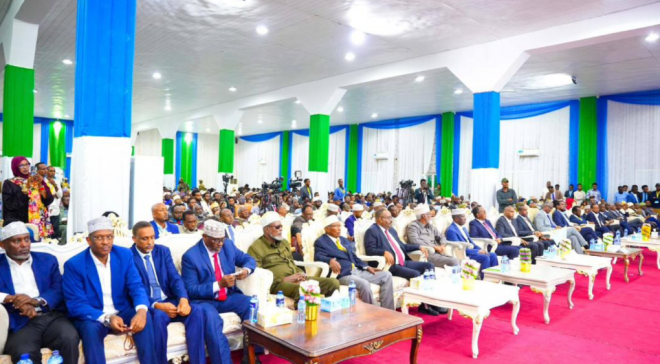Instability in Somalia after AMISOM, failed leadership
By Mohamed Haji Peso
Kenya has done what no other nation would or could do for the Somali people in the last two decades. Kenyans have welcomed about two million Somali refugees without conditions. However, everything changed when the Kenyan army entered Somalia on 16 October 2011 to aid the Somali Federal Government’s battle against Al Shabaab group. Despite years of international interventionism, there are three main causes, which propel instability in Somalia: the country’s failed leadership under Somali President Hassan Sheikh Mohamud; the actions of Kenya in Somalia; and the loss of faith in the Western-funded African Union Peacekeeping Mission in Somalia (AMISOM).
Some background information on Kenya, Somalia and Al-Shabab is helpful in analyzing this situation. Kenya is a long-standing security partner of the United States. It is a constitutional republic with universal suffrage and 47 counties. According to the 2009 census, Kenya’s population of nearly 46million people includes 3million Somali-Kenyans. In addition, about 500,000 Somali refugees live in Kenya. Per the census, the population is 82.5% Christian and 11.1% Muslim, and the reminder comprises of traditionalists, unspecified or non-believers. The CIA World Factbook reports that Kenya has a Tier 2 Watch List for trafficking in persons and specifically cites that Somalis, including children from the Dadaab refugee camp, are often forced into labor or prostitution within Kenya. Kenya is also referenced as massively corrupt and a transit country for drugs, as well as a source of money laundering (2015).
Somalia is officially in the process of becoming a federal republic and has a provisional constitution adopted in 2012. The United Nations and many countries recognize the Federal Government of Somalia (FGS); however, the FGS has limited control in the Mogadishu area while the rest of Somalia is ruled by regional and local governing bodies, including the self-declared “Republic of Somaliland” in northwest Somalia and the “Puntland” regional autonomy in northeast Somalia. In recent years, new regional administrations such as “Jubaland” in the country’s deep south and “Southwest State” have emerged.
The last official census was taken in 1975, but the CIA World Factbook estimates Somalia’s population at more than 10,600,000. The official religion of the country is Islam (Sunni). More than 1.1million people are considered Internally Displaced Persons (IDPs) within Somalia because of clan-based competition for power and resources, and other causes such as as conflict and famine (2015).
Al Shabaab is an al-Qaeda linked militant group fighting to topple the country’s weak Federal Government since 2006. Al Shabaab, meaning “the Youth” in Arabic, has an estimated fighting force of 7,000 to 9,000 men. While the group no longer controls major cities, it remains a dangerous force in the region through its suicide attacks, bombings and guerrilla war. In recent months, there have been reports that Al Shabaab is considering switching its allegiance from Al Qaeda to ISIS aiming to get support from militants in Iraq and Syria (BBC News, 2015).
Al-Shabab exploits the young generation of Somalis who are the target of a recruiting narrative that preaches that Kenya is the enemy of Islam and the Somalis. About 70% of the Somali population is under 30 years old. Al-Shabab is also actively recruiting in Kenya both of Somalis living there and from the non-Somali population. Actions of the AMISOM security forces in targeting disadvantaged Somalis have led to radicalizing young Muslims in Kenya. Three main causes empower the growing strength of terrorism in the area.
First, since entering Somalia, Kenya has developed a buffer region, arbitrarily arrested thousands of Somalis and closed Somali businesses in Kenya, begun construction of a border wall, and is claiming part of Somali seas as its own.
Al Shabaab has accused Kenyan-AMISOM troops of abuses in Somalia. In turn, the militants have launched regular cross-border attacks on police stations, tourism destinations, Nairobi’s West Gate Shopping Center, and most recently Garissa University College where 148 persons were killed in April 2015. The Kenyan government declares its neutrality in Somali affairs. But critics accuse it of establishing a “buffer zone” inside Somalia by aiding the Jubaland administration in Kismayo, where Kenyan-AMISOM troops are stationed. Somali federal leaders and Jubaland officials have ongoing disagreement over federalism and power sharing between federal and state authorities. In July, the FGS in Mogadishu submitted its dispute with Kenya to the International Court of Justice over a contested area of the Indian Ocean.
Second, Somali President Hassan Sheikh Mohamud has failed to lead and this also creates a void for instability to increase in Somalia and Kenya.
He has failed to unite the Somali people through reconciliation, to build a Somali national army, to destroy Al Shabaab’s capacity to attack Mogadishu and other cities, and to organize national elections in 2016. He has also failed to fulfill Somalia’s international obligations. He is president of Somalia in name only, relying entirely on the military power of AMISOM troops and the financial and humanitarian support of the United Nations and other foreign countries.
Third, the Somali public is losing or has lost faith in AMISOM.
Recently, AMISOM killed over 40 civilians in the Somali town of Merca and local elders have demanded that AMISOM to leave. The US is one of the largest international donors for relief, but the funding never reaches the needy. Federal leaders have publicly stated that “one man, one vote” national elections cannot take place in 2016.
Kenya’s open-border policy of the past welcomed many Somalis fleeing conflict, poverty and persecution. However, there are indications that Kenya’s new interventionist policy in Somalia is contributing to radicalization and guerrilla attacks within and beyond Somalia. Combined with failed leadership in Mogadishu and public distrust of AMISOM troops, Somalia seems headed towards further instability, terrorism and despair.
Mohamed Haji Peso is an educator and political commentator on Somali affairs.
Source: Somali Review







